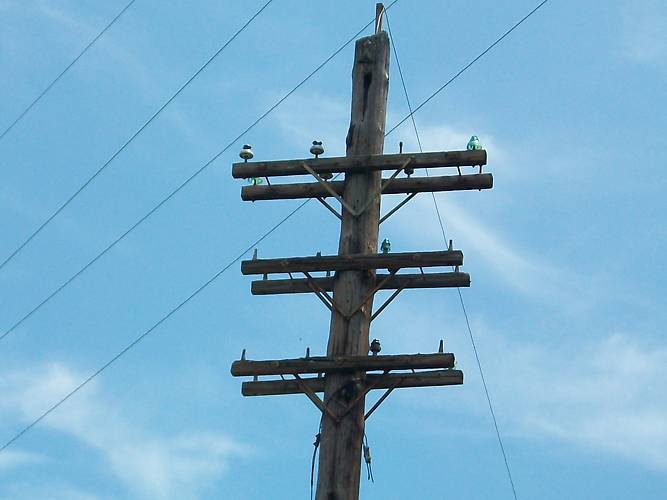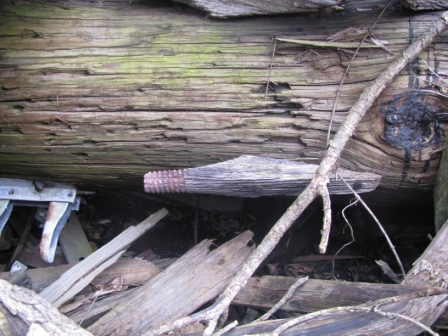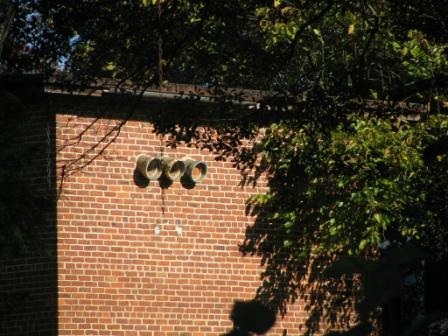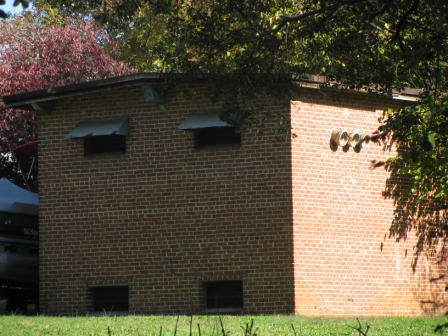
Upper Dam
Transmitting electricity to the Pelzer Mills and town of Pelzer, 1895 - 1989
Prior to 1894, most Southern cotton mills produced hydraulic power by steam engines or waterwheels and drove machinery by a complex system of belts and ropes. Using water wheels to create hydraulic power, the mills had to be located beside flowing rivers. In 1894, Columbia Mills, Columbia, SC was the first cotton mill to be driven by transmission of electricity. The Columbia Mills Hydroelectric Plant on the canal was designed and constructed by the General Electric Company and drove the mill nearby. Shortly after electricity was installed in the Columbia Mills, the Pelzer Manufacturing Company contracted the General Electric Co. to design and construct a hydroelectric plant similar to Columbia Mills, build a transmission line and install electric motors in the existing mills and future Mill No. 4.
The three existing mills, No. 1, 2 & 3 were driven hydraulically by damming the Saluda River. This dam was constructed of local stone in 1881. Mill No. 1 & 2 were driven by two water wheels located underneath Mill No. 1 and Mill No. 3 was driven by a 450 HP steam engine. There were an estimated 52,000 spindles in Mills No. 1, 2 & 3 before Mill No. 4 went into operation. Mill No. 4 was to be an estimated additional 68,000 spindles. Estimates from American Electrician, November, 1900.
The hydroelectric dam was built 2 1/5 miles downstream from Pelzer on the Saluda River. Three General Electric Co. 750 kilowatt, three-phase generators produced 3,300 volts in the powerhouse. In 1895, the hydroelectric plant was completed.

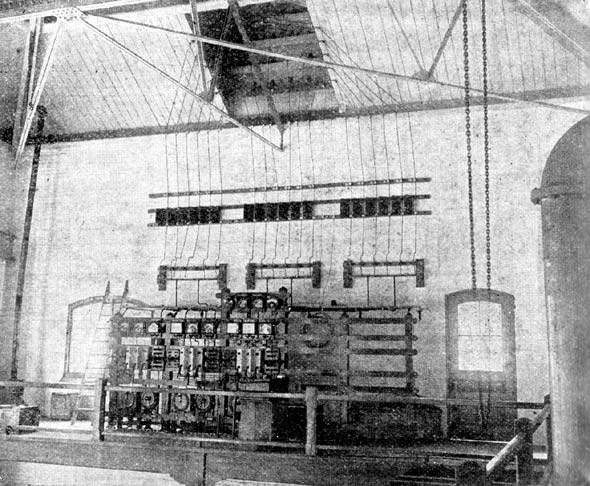
"Generator Room" Three GE 750 HP generators. From Electrical World, Saturday, March 14, 1896 (Left)
"Switchboard" Inside the powerhouse showing the main switchboard. From Electrical World, Saturday, March 14, 1896 (Right)
3,300 volts were fed directly to the 2 1/2 mile transmission line which had 18 00 gauge copper wires. Each pole had five crossarms, the top arm held two static wires, grounding every third pole, the three middle crossarms carried the 18 conductors, and the lower arm were 'pressure' and telephone wires. About 3/4th of the length to Mill No. 4, the line branched to Mill No. 3 with No. 4 B. & S. type wires. The transmission line also fed a substation providing the mill homes and town buildings with lights.
|
00 gauge copper wire with part of an iron tie wire. |
CD 245 insulator with the original 00 gauge copper wire and iron tie wire found in Pelzer. Photo by Paul Greaves. |
Mill No. 3
In Mill No. 3, the wires enter a small lightning arrestor tower and lead to nine GE 'air blast' transformers and two transformers reducing the current to 114 volts in the basement. Three of the six are a max of 265 kilowatts and six are a max of 275 kilowatts. The two small transformers are for the incandescent lighting in Mill No. 3. A single 400 HP motor was installed in Mill No. 3 and was more economical then Mill No. 3's old steam engine.
Mill No. 4
The mainline to Mill No. 4 enters a lightning arrestor tower and travel through a tunnel into the mills basement. In the basement were transformers, from which wire led to twenty-four ceiling-mounted GE motors and 1,200 incandescent lights. Mill No. 4 was a testing ground for new electric cotton mill machinery in the 1890s and early 1900s.
General Electric Motors
The following information below was gather from Electrical World, Saturday, March 14, 1896
-
Two 50 HP for the basement ventilation.
-
Four 75 HP on the first floor for the picking room.
-
Four 110 HP powering 720 looms on the first floor, 680 looms on the second floor and 5 slashers.
-
Three 110 HP powering carding on the third floor.
-
Eight 110 HP powering spinning on the forth floor.
-
Two 5 HP for pumps.
Additions to the Lower Dam
As the town and mills grew, the demand for electricity increased. In 1908, a 250 kilowatt generator was added to the Lower Dam powerhouse and in the 1930s, a 2000 kilowatt generator was added. Information from North Fork Electric Inc.
Upper Hydroelectric Dam
Completed in 1920 by the General Electric Co. contracted by the Pelzer Manufacturing Company, the dam originally constructed for hydraulic power in 1881 was converted to produce hydroelectric power. A short transmission line extended from the Upper Dam powerhouse to Mill No. 1's generator room. The dam provided Mills No. 1 & 2 and the town with additional electricity.

Transmission line from the Upper Dam powerhouse leading to Mill No. 1's generator room in the 1980s. Photo by Bill Cunningham.
The Lower Dam Transmission Line
Mainline from the Lower Dam to the Mill No. 3 branch - 1 3/4 miles
The Lower Dam transmission line had been in service over 100 years. From the Lower dam to the branch leading to Mill No. 3, the original 1895 poles had three, six wood pin crossarms with CD 245 insulators. The top and bottom crossarms were four wood pin crossarms, the top arm had two CD 245 for static wires and the bottom used glass signal style insulators.

Photo taken in 1896 of the Lower Hydroelectric Dam and outbound transmission line to Pelzer. From Electrical World, Saturday, March 14, 1896
Branch to Mill No. 3 - 1/4 mile
Mill No. 3's branch from the mainline used No. 4 B & S type wires divided onto three, four wood pin crossarms. The arms held CD 245 insulators. Telephone lines were located on side pins attached below the crossarms. The power line wires were 00 gauge, copper type. A small line lead to a transformer house where the electricity was converted to lower voltage for distribution lines in the village. The transformer house was located near Mill No. 2.
|
Example of two, four wood pin crossarms on a tall double-crossarm pole crossing the P & N tracks. The top arms replaced wood pin arms. This pole was most likely installed in 1912, when the P & N railroad was laid in Pelzer, to cross over the P & N catenary and power lines. Two crossarms reduced strain and weathered better then one. Photo by Mike Herron. |
A wooden side pin is still attached to a pole in a scrap pile where Mill No. 3 stood.
|
Line to Mill No. 4 - 3/4 mile
Mill No. 4's line had three, five wood pin crossarms with CD 245 insulators. The wires were of 00 gauge, copper type. A transformer house is located near Square St. behind a two-story house. The transformers lowered the voltage for distribution to mill homes and other buildings.
An empty pole near the Pelzer EMS building with three, five steel pin crossarms.
|
|
|
|
The transmission line to Mill No. 4 powered a small transformer house which distributed electricity to the mill homes. Distribution wires exited the building through large clay pipes. |
|
Upgrades on the Transmission Line
Throughout the years of use poles, crossarms, insulators and other materials would become outdated or broken on the power line. Early upgrades were replacing broken insulators, crossarms and poles. Some of the oldest poles in Pelzer have wood pin crossarms and have a large diameter. Post 1950s, modern Chance Line Material insulators were used as replacements, old wood pin crossarms were replaced with steel pin crossarms (there were several different styles of arms), and the two static wires on the top crossarm were replaced with a single aluminum wire and support bar. Old insulators like the CD 245 were reused on the new arms and because of it, the CD 245 was one of the oldest glass insulators in service in America with 94 years of continuous service.
A tall pole used for crossing the P & N railroad most likely installed around 1912. Photo by Mike Green.
|
This short pole near the Lower Mill site has two types of steel pin crossarms with various replacement insulators. The glass insulators were first generation replacements, while the porcelain insulators are more modern replacements. Photo by Mike Herron. |
A Leaning pole near the Lower Mill site shows the difference between a steel pin crossarm, top, and wood pin crossarms. Sadly, in late 2010, this pole disappeared. Photo by Mike Herron. |
The Final Years of Pelzer mills Electricity
In 1989, Gerber sold the hydroelectric plants to ENEL North America. when the transmission line was decommissioned, the Pelzer Mills became dependent on electricity from the Duke Power Company (Duke Energy). Linemen removed the valuable copper wires from the poles in the late 1980s. For quick removal, some linemen smashed the insulators apart.
Over the neat 30 years, an insulator collector from Florida passed through Pelzer and discovered the poles in town loaded with CD 245. He claims that the line was checked out by a few different collectors but he was the first to act on removing the insulators when another friend offered $20 for each mint one. In his return to Pelzer, he found around 150 CD 245 and 80% of them were on the ground from the linemen removing the wires. Many of the insulators were badly damaged from removal as the linemen simply smashed the glass to remove the valuable wire. Past that time, various collects have found what they could on the ground and on poles. In 2001, another insulator collector 'rediscovered' the line and worked on removing the remaining CD 245 in town. About 50 insulators were saved. The CD 245 is an early high voltage style, known as rare in the hobby, and a mint example will fetch at most $100 (even more depending on the book pricing) but, the hobby is now flooded with CD 245 creating a wide range of value depending on what collectors will pay.
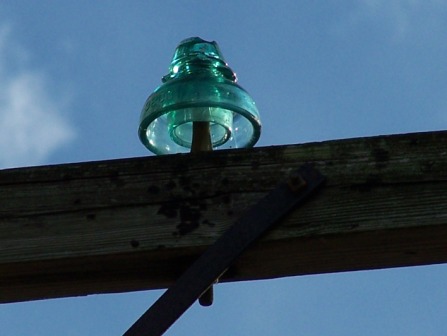
One of a few remaining CD 245 in Pelzer. Photo by Dave Kingston.
Articles
Electrical World - Article provided by www.insulators.info
Electrical Doings - Article provided by www.insulators.info
American Electrician - Article provided by www.insulators.info
Jeffrey Kraemer. E-mail: th9200jk@aol.com

